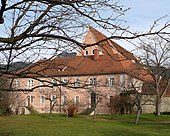Assumption of Mary (Frohnleiten)
The Church of the Assumption of Mary is the Roman Catholic parish church of Frohnleiten in Styria . Its history goes back to the 17th century.
location
The church stands at the western end of the main square of Frohnleiten next to the old Katharinenkirche .
history
The church was built as the monastery church of the Servite monastery between 1679 and 1689 by Jakob Schmerlaib . It was consecrated to the Assumption in 1701 . Badly damaged by fire in 1763, it was rebuilt in the following years. The reconstruction took place without the original church tower, which was on the gable facade. In 1786 the parish rights were transferred from St. George's Church in Adriach to the new church in Frohnleiten. Between 1826 and 1845 the church belonged to the Redemptorist Order, and between 1845 and 1967 it was again a member of the Servites . From then on the church was looked after by the Franciscan order . It was restored in 1964. After more than 50 years of pastoral care, the Franciscans from the Mostar province left the monastery in Frohnleiten at the end of August 2018 due to a lack of young people. Since then, pastoral care has been provided by the diocese of Graz-Seckau with a diocesan priest .
description

The towerless outer facade of the church building has volute gables and is structured by flat pilasters . There are niches with baroque stone statues above the entrance portal and on the two side axes . These date from the first half of the 18th century and depict the saints Juliana von Falconieri , Philipp Benizi and Peregrinus Laziosi .
The church was built as a three- bay wall pillar church with a drawn-in, straight, two-bay choir . The Rococo interior is spanned by a square vault. The pillars with decorative paintings are crowned by powerfully formed cornice capitals .
The gallery in the east has a Rococo railing and rests on two columns. The main pulpit opposite is another, Johannes Nepomuk consecrated pulpit. Both pulpits as well as the altars, confessionals, oratorios and portals date from around 1764. The white-framed statues probably come from Veit Königer , the choir stalls from the first third of the 19th century, designed in the Biedermeier period .
The altar panel of the main altar depicts the Assumption of Mary . On the altar panels of the eastern side chapels, Saint Philip Benizi and Saint Francis von Paola are depicted. In the choir there is a portrait of the intercessor Maria and in the nave there is one of Esther before Ahasver , the Madonna Enthroned and one of King Solomon and the Queen of Sheba . There is also a representation of King David on the eastern wall. The four continents are represented in the spandrels of the central yoke. The wall painting and the altar leaves were painted by Joseph Adam Ritter von Mölk and his student Josef Strickner in 1764. The altarpiece in the Josephaltar was designed by Josef Sutter in 1829. On the opposite altar the foundation of the Servite Order is depicted. This work dates from 1895 and was made by Ludwig von Kurz zum Thurn und Goldenstein .
literature
- Federal Monuments Office (ed.): Dehio Steiermark (excluding Graz) . 2nd Edition. Berger, Horn / Vienna 2006, ISBN 3-85028-439-5 , p. 117-119 .
Web links
Coordinates: 47 ° 16 ′ 12.1 ″ N , 15 ° 19 ′ 28 ″ E


